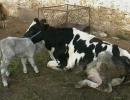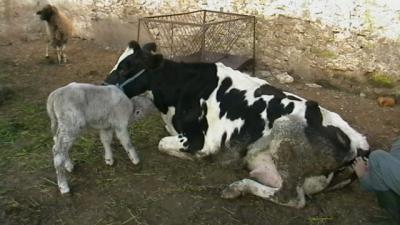
|
Milk fever
Scientific name:
Parturient paresis
Local names:
Kikuyu: Murimu wa iria
Description:
Management disease
|
Introduction
Milk fever is a disease of mature cows, occurring a few days before, but mostly just after calving. It is common in imported high yielding dairy cows, especially Channel Island breeds such as Jerseys or Guernseys. Milk fever is not known in the indigenous stock. Milk fever is caused by low calcium levels in the body due to the sudden onset of lactation at calving. The nutritional status of the cow in the dry period is known to influence the risk of the disease. Diets low in dry matter such as lush pastures and diets with high calcium during dry period can predispose the cow to milk fever. Low magnesium in the diet hinders absorption of calcium and hence is predisposing to milk fever.
The disease is more risky in cows after third calving and is rare in calving heifers.
The disease is more risky in cows after third calving and is rare in calving heifers.
Signs of Milk fever
- The first sign of the disease is loss in appetite followed by slight drop in temperature.
- The affected animal become uncoordinated, fall over and remain seated with the head resting on the shoulder.
- Dull eyes and shivering, constipation is a common feature and sometimes a goose-stepping gait is seen.
- If not treated immediately, the animal may go into coma and die within a day after the first signs. Since the rumen stops functioning, bloat becomes a complication and may cause death
Prevention - Control - Treatment
Prevention and Control
- Feed the cow with the correct levels of nutrients from the late pregnancy to peak lactation
- Feed diets with the right dry matter content such as offering additional hay in combination with lush pasture.
- Feed balanced mineral supplement which appreciates the inter-relationship between calcium and magnesium
Recommended treatment
If the cow is found to be lying on her side she should be immediately propped on to her chest. Otherwise she is liable to get bloat or inhale stomach content with the attendant risk of developing aspiration pneumonia. But do NOT use rocks or boulders!
Slow intra venous infusion 400 ml of 20% calcium borogluconate should be administered as soon as is possible. If this is difficult then give the same volume by subcutaneous injection. Give in several sites and massage the sites of injection to disperse the solution. At the same time remove the calf. Response to treatment is seen by the cow belching, snapping and opening her eyelids, breathing deeply, passing dung and sitting up. Even if the cow appears to be unconscious give i/v calcium. Even cases which look hopeless can recover. The calf should be removed and the cow not milked for 24 hours. On day two milk half the estimated volume from each quarter and feed this to the calf. On day three milk normally. If the calf is allowed unrestrained access to the cow or if unrestrained milking is carried out the cow may well go down again. Get a flutter valve and have it clean and ready for use. There is nothing more frustrating than trying to give 400 ml calcium by i/v injection with a 20 ml syringe and it is guaranteed to damage the jugular vein.
Information on Pests and Diseases
- Barber, J., Wood, D.J. (1976) Livestock management for East Africa: Edwar Arnold (Publishers) Ltd 25 Hill Street London WIX 8LL
- Blood, D.C., Radostits, O.M. and Henderson, J.A. (1983) Veterinary Medicine - A textbook of the Diseases of Cattle, Sheep, Goats and Horses. Sixth Edition - Bailliere Tindall London. ISBN: 0702012866
- Blowey, R.W. (1986). A Veterinary book for dairy farmers: Farming press limited Wharfedale road, Ipswich, Suffolk IPI 4LG
- Force, B. (1999). Where there is no Vet. CTA, Wageningen, The Netherlands. ISBN 978-0333-58899-4.
- Hall, H.T.B. (1985). Diseases and parasites of Livestock in the tropics. Second Edition. Longman Group UK. ISBN 0582775140
- Hunter, A. (1996). Animal health: General principles. Volume 1(Tropical Agriculturalist) - Macmillan Education Press. ISBN: 0333612027
- Hunter, A. (1996). Animal health: Specific Diseases. Volume 2(Tropical Agriculturalist) - Macmillan Education Press. ISBN:0-333-57360-9
- ITDG and IIRR (1996). Ethnoveterinary medicine in Kenya: A field manual of traditional animal health care practices. Intermediate Technology Development Group and International Institute of Rural Reconstruction, Nairobi, Kenya. ISBN 9966-9606-2-7.
- Pagot, J. (1992). Animal Production
- The Organic Farmer magazine No. 50 July 2009

 Back
Back
